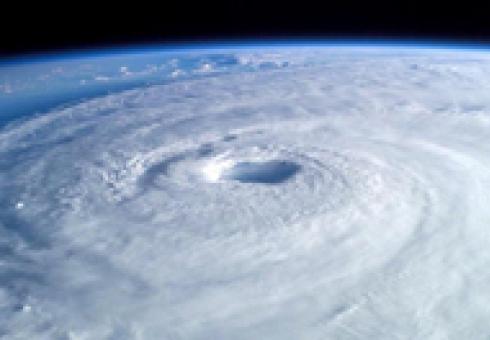CS3 In the News
By: Janet Pelley March 28, 2013
By 2100, the world population will pass 10 billion people. How can we sustain that population, while throttling back climate change? Some scientists think part of the answer is to plant forests and grow biofuel crops, allowing us to use land to sequester carbon. But those changes in land use also could crowd out food crops, raising the cost of food. In ES&T’s Best Policy Analysis Paper of 2012, researchers model the feedback between the atmosphere, Earth’s ecosystems, and the global economy to show that a fossil fuel tax plus incentives for reforestation and biofuels nearly stabilizes the climate by 2100. Unfortunately, the team reports that the trade-off is a hefty rise in food prices (Environ. Sci. Technol., DOI: 10.1021/es2034729).
John Reilly, an energy economist at Massachusetts Institute of Technology, and his team realized that any analysis of climate policies, such as a carbon tax or incentives for reforestation, is complicated by the fact that land use policy, climate, and the economy are tightly linked. For example, as the climate warms, plant productivity changes, which in turn affects people’s decisions about land use, he says. “Thinking of that complex set of interactions and trying to understand what was going on was the motivation for the study,” Reilly says
Previous studies have narrowly focused on one land use at a time, such as finding the best policies to sequester more carbon in forests but ignoring spillover impacts on cropland. Also these studies did not take into account the interactive and downstream effects of a worldwide carbon tax.“Reducing greenhouse gases with a carbon tax will increase energy costs, and energy is a big input in agricultural production,” Reilly says.
His team decided to study a combination of policies—a carbon tax and incentives for reforestation and biofuels—and ask what the effects would be on the climate, food prices, and land use.
To do so, they developed a set of three models that feed data among one another. First, a global economic model, provided by the MIT team, predicts food prices, land use, and greenhouse gas emissions every five years. Next, those emissions estimates drive a climate model that simulates future climate conditions. These climate outputs, such as carbon dioxide and ozone concentrations, then feed into an ecosystem model, developed by Jerry M. Melillo and his team at the Woods Hole Oceanographic Institution. The ecosystem model generates changes in crop and forest productivity. The economic model then uses these productivity changes, along with expected demand for products produced from the land, to reassess land and energy use, which then determines the next set of greenhouse gas emissions estimates. And the cycle continues.
The team members ran their models through the year 2100 under several different policy scenarios. They found that if humanity sticks with the status quo and attempts no change in climate policy, CO2 concentrations reach 900 ppm by 2100, and global mean temperature hits 5.8 °C above preindustrial levels. However, a worldwide tax on fossil fuel emissions limits the CO2 concentration to 520 ppm and holds temperature rise to 2.7 °C. These metrics are still above the targets set by the 2009 Copenhagen Accord, which are a 2 °C temperature increase and CO2 levels around 450 ppm CO2.
When the team added incentives for reforestation and biofuels to a tax on energy, CO2 concentrations reach only 490 ppm and global temperature increases 2.2 °C over preindustrial levels by the end of the century. But Reilly says these better climate statistics come at a price: Competition for agricultural land from reforestation and biofuels boosts food prices by 80%.
Stephen Polasky, an environmental economist at the University of Minnesota, Twin Cities, says that this paper reveals that policy makers cannot think of energy and food policies as independent.
Even though the scenarios in the paper are far more aggressive than any proposed policies suggested right now, fossil fuel use in the models never drops to levels scientists say we need to stabilize the climate, says Steve Running, a terrestrial carbon scientist at the University of Montana. He also says the paper highlights how any solution to the climate problem requires choices and trade-offs when it comes to land use.
Reilly hopes that others will adopt his team’s modeling practices to find sensible polices to improve the climate.
The authors declare no competing financial interest.
Most efforts to address carbon emissions focus on preventing them from entering the atmosphere in the first place. But how to get rid of CO2 already there? Start-ups are developing prototype air-capture systems.
Introduction
Of all the uncertainties climate change presents, its impact on the production and distribution of food is one of the greatest. We are already feeling the effects: 2012 was a bad year for farmers, with droughts and erratic weather decimating crops and pushing up global food prices. Food prices are at historic highs and there have been two global food crises in the last five years leading to riots in Haiti in 2008 and contributing to the Arab Spring in 2011.
Molly D. Anderson and John Reilly examine the complex challenges and trade-offs humanity faces in a world where climate change is upending traditional assumptions about where and how we can produce enough food for the world’s rapidly growing population.
Molly D. Anderson is a professor at College of the Atlantic and holds the Patrtridge Chair in Food and Sustainable Agriculture Systems.
Until just a few years ago, there were some blithe assumptions about how climate change would affect food security: Like migrating birds, agriculture will simply move north to escape extreme heat, and only food production will be affected by climate change.
Today we recognize that it’s not just temperature, but a whole set of complex interrelated factors — temperature, rainfall, timing, soils, practices throughout the food system and more — that are affected by climate change.
Each crop has its own ideal set of circumstances. Having too many warm nights can be deadly for some crops. Not having enough hours of nighttime freeze can hurt others. Human societies have evolved with agriculture over the last 10,000 years to use particular crops in particular places. Now we’re experimenting with drastic changes in a matter of decades.
It’s not going to be easy, for a number of reasons, for agriculture to just move north. Farming is one of the most place-based occupations in the world. Farmers won’t easily pick up and move north. If they do, the soil they’ll find will be completely different.
Climate change isn’t just affecting the production of food; it’s also affecting consumption of and access to food. Ocean acidification will lower fish catches, which in turn will increase demands on land-based foods. Climate refugees will need new access to food, yet will be unable to produce their own. Food safety will become more challenging.
Food security, as defined by the Food and Agriculture Organization of the UN (FAO), is “when all people, at all times, have physical, social and economic access to sufficient, safe and nutritious food that meets their dietary needs and food preferences for an active and healthy life.”
Even without climate change, with the growing world population, food security will present a challenge. We need to look for win/win solutions — ones that improve food security and sustainability of food systems on the one hand and that mitigate and adapt to climate change on the other.
On the farm level, this means promoting the use of renewable energy in food production, restoring degraded soils and diversifying crops.
On a state and regional level, it means first recognizing food as a basic human right and then making policy decisions that flow from that recognition. For example, using land to produce food would take priority over using land to produce biofuels or animal feed; and states and regions would establish adequate food reserves and be able to set their own food and trade policies. States and regions must promote energy and water efficiency throughout the food system as well.
Globally, we need to slow population growth. One of the most effective ways to do that is to educate girls and women and provide access to contraceptives. We also need to reduce food waste and over-consumption, particularly by wealthy people and nations of the world.
When it comes to food security, the developed world is answering the wrong questions. We’ve focused on increasing availability of food and “feeding the world” (to the benefit of our own corporations). We need to focus on improving food access, reducing our own over-consumption, and addressing why poor people can’t feed themselves in a world with more than enough food for all its inhabitants.
John Reilly is senior lecturer and co-director of the Joint Program on the Science and Policy of Global Change and a senior lecturer at the MIT Sloan School of Management.
Since 1980, the world’s breadbaskets — areas where major crops like maize, wheat, rice, and soy beans are grown — have warmed significantly. Interestingly, the U.S. is the major exception to this global trend. Our agricultural regions have actually experienced somewhat cooler temperatures overall — with a few exceptions.
The effects of climate change on agriculture are likely to be mixed, benefiting crops in some areas and harming crops in others. In colder regions, like New England and much of Canada, growing seasons are becoming longer. We can expect lower crop yields in regions where heat exceeds critical thresholds.
Just as agriculture is a major cause of greenhouse gas emissions, it could also play a major role in mitigating climate change.
Scientists estimate that doubling CO2 concentrations from pre-industrial levels would increase crop yields by as much as 20 to 30 percent, but would also increase the growth of weeds. Furthermore, the increase in crop yields from the effects of more carbon dioxide in the air would largely be offset by the effects of increased temperatures and decreased soil moisture.
Agriculture and climate are both highly complex pieces of the Earth’s ecosystem. Constructing reasonably accurate, useful models of how the two interact is an enormous scientific challenge.
My colleagues at MIT and I have begun developing a model for predicting crop yield changes in the world’s breadbasket regions. We’ve found wide variations in how yields are likely to be affected by climate change. Generally speaking, whether we looked at maize (corn) in North America and West Africa, wheat in Europe and Asia, or soybeans in South America, the results were the same: Areas closer to the equator saw declining yields, some up to 50 percent, while areas closer to the North and South Poles showed increased yields. They balance out at some level, but this kind of change would cause lots of dislocation.
With global population projected to peak at 10 billion sometime after 2050, and with rising incomes allowing more people to eat a resource-intensive diet (i.e. eating more meat), we face great agricultural challenges even without the dislocation and disruption climate change will cause.
Just as agriculture is a major cause of greenhouse gas emissions, it could also play a major role in mitigating climate change. Our studies show that an aggressive global reforestation policy could result in a half-degree Celsius of avoided warming by 2100. The key would be putting a price on carbon for removing carbon dioxide from the atmosphere. This price would create an incentive for landholders to reforest their land, because forests are great absorbers of carbon.
Reforestation comes at a cost. More land for forests means less land for agriculture. That means we could expect to see higher food prices, especially for livestock.
This is part of the trilemma of what to do with land in the 21st century. Do we use it to produce biofuels as a substitute for fossil fuels? Do we use it to produce food? Do we use it to preserve biodiversity and store carbon?
There are unavoidable trade-offs no matter what we decide. There are no easy solutions when it comes to climate change and food security. What is clear is that the worst “solution” would be continued inaction in the face of the overwhelming evidence that climate change has real and growing effects.
On Tuesday, four Democrats in Congress unveiled a brand-new proposal for a carbon tax. The set-up is simple: The U.S. government would slap a fee on fossil-fuel emissions and refund the revenue back to the public.
But there’s a twist: The precise details of the carbon tax have yet to be thrashed out. The four lawmakers are soliciting public comments for how big the tax should be and how best to rebate the money.
The proposal is being put forward by Reps. Henry Waxman and Earl Blumenauer, as well as Sens. Sheldon Whitehouse and Brian Schatz.
Here are the key questions they’re wrestling with:
1. What is the appropriate price per ton for polluters to pay? The draft contains alternative prices of $15, $25 and $35 per ton for discussion purposes.
2. How much should the price per ton increase on an annual basis? The draft contains a range of increases from 2 percent to 8 percent per year for discussion purposes.
3. What are the best ways to return the revenue to the American people? The discussion draft proposes putting the revenue toward the following goals, and solicits comments on how to best accomplish each: (1) mitigating energy costs for consumers, especially low-income consumers; (2) reducing the Federal deficit; (3) protecting jobs of workers at trade-vulnerable, energy intensive industries; (4) reducing the tax liability for individuals and businesses; and (5) investing in other activities to reduce carbon pollution and its effects.
4. How should the carbon fee program interact with state programs that address carbon pollution?
Those are, indeed, difficult questions. So let’s take a look at each of them in turn:
1) How big should the carbon tax be? Economists have long argued that a carbon tax can be an elegant way to tackle climate change. If you tax oil, coal, and natural gas and make them more expensive, then people and companies will either use fewer fossil fuels or seek alternatives. Markets will adjust to the new price.
But there’s plenty of dispute over what the appropriate price on carbon emissions should be. For that, you need to figure out how much damage heat-trapping greenhouse gases are actually causing — and figure out how highly to value future generations. The federal government currently pegs the “social cost of carbon” at $21 per ton. Other economists have concluded that the price should be up to 12 times as much.
2) How quickly does the tax need to rise to curtail emissions? A tax that rises each year should, in theory, drive down emissions. But a lot could depend on how quickly the tax actually rises.
Here’s one example: Sebastian Rausch and John M. Reilly of the MIT Global Change Institute recently put forward a proposal for a $20-per-ton carbon tax that would rise 4 percent each year, starting in 2013. (The funds would be used to offset taxes elsewhere.) Here’s what their model predicts would happen to U.S. greenhouse-gas emissions:
Under this proposal, U.S. greenhouse gas emissions do start declining quite a bit (this is the green line), with a relatively small impact on the U.S. economy. But by 2030, emission levels stall, even though the carbon tax keeps rising by 4 percent each year. The United States wouldn’t get anywhere near the 80 percent cut by 2050 that the White House has envisioned.
It’s possible the MIT model is too pessimistic or wrong. It’s also possible that deeper emissions cuts might require a carbon tax that rises even more sharply. But a higher tax could also prove more costly to the economy unless it’s offset properly. So there’s a delicate trade-off here.
3) What’s the best way to use the carbon tax revenue? A carbon fee usually gets criticized for hurting poorer Americans the most—they spend the biggest slice of their income on gasoline and other energy-intensive products, after all. But Rausch and Reilly found that a lot of the distributional effects depend on how Congress rebates the revenue, as shown in the chart below:
The green line shows how different income groups would be affected in 2015 if the carbon tax was used to fend off cuts to social welfare programs like Medicaid. Lower-income Americans would benefit significantly, while wealthier Americans would take a small hit.
By contrast, the red and blue lines show the effects if revenue from the carbon tax was used to cut the corporate tax or personal income tax—in those cases, higher-income Americans would come out ahead.
If, however, carbon tax revenue was used to cut payroll taxes—that’s the black line—then the welfare effects in 2015 are more or less neutral.
On the flip side, some experts like Mark Muro of Brookings have argued that a portion of the revenue raised by a carbon tax should be used to fund public clean-energy R&D. The country won’t wean itself off oil solely because carbon gets taxed. We’ll also need public-transit alternatives, or electric-vehicle infrastructure, or futuristic new hydrogen cars. And in many cases, Muro argues, the government may have to help bankroll this infrastructure.
4) How does the carbon tax interact with the states? California is currently operating its own comprehensive program to cut greenhouse-gas emissions 80 percent by 2050. And 10 states in the Northeast have a small cap-and-trade program for electric utilities. Should these states somehow get “credit” for moving early on global warming? And what’s the best way to do that under a carbon-tax system?
In any case, these are all difficult questions. Those who want to join in on this debate can submit comments to the lawmakers at cutcarbon@mail.house.gov. The comment period ends April 21.
By Brad Plumer
February 22, 2013
What’s the best way to curtail gasoline consumption? Economists tend to agree on the answer here: Higher gas taxes at the pump are more effective than stricter fuel-economy standards for cars and trucks.
Much more effective, in fact. A new paper from researchers at MIT’s Global Change program finds that higher gas taxes are “at least six to fourteen times” more cost-effective than stricter fuel-economy standards at reducing gasoline consumption.
Why is that? One of the study’s co-authors, Valerie Karplus, offers a basic breakdown here: Fuel-economy standards work slowly, as manufacturers start selling more efficient vehicles, and people retire their older cars and trucks. That turnover takes time. By contrast, a higher gas tax kicks in immediately, giving people incentives to drive less, carpool more, and buy more fuel-efficient vehicles as soon as possible.
A great deal also depends on whether biofuels and other alternative fuels are available. A tax on gasoline makes these alternative fuels more competitive, whereas fuel-economy standards don’t. “We see the steepest jump in economic cost between efficiency standards and the gasoline tax if we assume low-cost biofuels are available,” Karplus said in an MIT press release.
And yet… all this economic research never seems to have any effect on lawmakers. Since 2007, Congress and the Obama administration have moved to increase federal fuel economy standards, now scheduled to rise to 54.5 miles per gallon by 2025. According to the MIT estimates, this will cost the economy six times as much as simply raising the federal gas tax from its current level of 18.4 cents per gallon to 45 cents per gallon. Yet no one in Congress has even proposed the latter option.
One explanation is that the public just prefers things this way. Higher fuel-economy standards do impose costs, but they’re largely “hidden” costs — in the form of pricier vehicles in the showroom. A higher gas tax, by contrast, is visible every time people fill up at the pump.
In fact, a recent NBER paper by MIT’s Christopher Knittel found that this has been the case for decades. Between 1972 and 1980 the price of oil soared 650 percent. There was endless public debate during this period about how best to reduce reliance on fossil fuels. And, as Knittel discovered, the public consistently preferred price controls and fuel-economy standards over higher gas taxes. That was true no matter how often people were informed that gas taxes were the superior option.
“Given the saliency of rationing and vehicle taxes,” Knittel concluded, “it seems difficult to argue that these alternative polices were adopted because they hide their true costs.” In other words, the public seems to have an (expensive) preference for inefficient regulations over higher taxes to curb gasoline. Economists find it maddening, but it’s hard to change.
Further reading:
–On the other hand, if you want to see a rare economic argument for fuel-economy standards, check out this 2006 paper (pdf) by Christopher Knittel. He found that Americans were becoming less sensitive to fuel prices over time — which strengthened the case for policies like CAFE standards.
THE average price of gasoline in the United States, $3.78 on Thursday, has been steadily climbing for more than a month and is approaching the three previous post-recession peaks, in May 2011 and in April and September of last year.
But if our goal is to get Americans to drive less and use more fuel-efficient vehicles, and to reduce air pollution and the emission of greenhouse gases, gas prices need to be even higher. The current federal gasoline tax, 18.4 cents a gallon, has been essentially stable since 1993; in inflation-adjusted terms, it’s fallen by 40 percent since then.
Politicians of both parties understandably fear that raising the gas tax would enrage voters. It certainly wouldn’t make lives easier for struggling families. But the gasoline tax is a tool of energy and transportation policy, not social policy, like the minimum wage.
Instead of penalizing gasoline use, however, the Obama administration chose a familiar and politically easier path: raising fuel-efficiency standards for cars and light trucks. The White House said last year that the gas savings would be comparable to lowering the price of gasoline by $1 a gallon by 2025. But it will have no effect on the 230 million passenger vehicles now on the road.
Greater efficiency packs less of a psychological punch because consumers pay more only when they buy a new car. In contrast, motorists are reminded regularly of the price at the pump. But the new fuel-efficiency standards are far less efficient than raising gasoline prices.
In a paper published online this week in the journal Energy Economics, I and other scientists at the Massachusetts Institute of Technology estimate that the new standards will cost the economy on the whole — for the same reduction in gas use — at least six times more than a federal gas tax of roughly 45 cents per dollar of gasoline. That is because a gas tax provides immediate, direct incentives for drivers to reduce gasoline use, while the efficiency standards must squeeze the reduction out of new vehicles only. The new standards also encourage more driving, not less.
Other industrialized democracies have accepted much higher gas taxes as a price for roads and bridges and now depend on the revenue. In fact, Germany’s gas tax is 18 times higher than the United States’ (and seven times more if the average state gas tax is included). The federal gasoline tax contributed about $25 billion in revenues in 2009.
Raising the tax has generally succeeded only when it was sold as a way to lower the deficit or improve infrastructure or both. A 1-cent federal gasoline tax was created in 1932, during the Depression. In 1983, President Ronald Reagan raised the tax to 9 cents from 4 cents, calling it a “user fee” to finance transportation improvements. The tax rose again, to 14.1 cents in 1990, and to 18.4 cents in 1993, as part of deficit-reduction deals under President George Bush and President Bill Clinton.
A higher gas tax would help fix crumbling highways while also generating money that could help offset the impact on low- and middle-income families. Increasing the tax, as part of a bipartisan budget deal, with a clear explanation to the public of its role in lowering oil imports and improving our air and highways, could be among the most important energy decisions we make.
Valerie J. Karplus is a research scientist in the Joint Program on the Science and Policy of Global Change at M.I.T.
Read more about the study here.
Related: Carbon Tax a 'Win-Win-Win' for America's Future
Nature: Natural hazards: New York vs the sea
By: Jeff Tollefson
February 13, 2013
In the wake of Hurricane Sandy, scientists and officials are trying to protect the largest US city from future floods.
Joe Leader's heart sank as he descended into the South Ferry subway station at the southern tip of Manhattan in New York. It was 8 p.m. on 29 October, and Hurricane Sandy had just made landfall some 150 kilometres south in New Jersey. As chief maintenance officer for the New York city subway system, Leader was out on patrol. He had hoped that the South Ferry station would be a refuge from the storm. Instead, he was greeted by wailing smoke alarms and the roar of gushing water. Three-quarters of the way down the final set of stairs, he pointed his flashlight into the darkness: seawater had already submerged the train platform and was rising a step every minute or two.
“Up until that moment,” Leader recalls, standing on the very same steps, “I thought we were going to be fine.”
Opened in 2009 at a cost of US$545 million, the South Ferry station is now a mess of peeling paint, broken escalators and corroded electrical equipment. Much of Manhattan has returned to normal, but this station, just blocks from one of the world's main financial hubs, could be out of service for 2–3 years. It is just one remnant of a coastal catastrophe wrought by the largest storm in New York's recorded history.
Sandy represents the most significant test yet of the city's claim to be an international leader on the climate front. Working with scientists over the past decade, New York has sought to gird itself against extreme weather and swelling seas and to curb emissions of greenhouse gases — a long-term planning process that few other cities have attempted. But Sandy laid bare the city's vulnerabilities, killing 43 people, leaving thousands homeless, causing an estimated $19 billion in public and private losses and paralysing the financial district. The New York Stock Exchange closed for the first time since 1888, when it was shut down by a massive blizzard.
As the humbled city begins to rebuild, scientists and engineers are trying to assess what happened during Sandy and what problems New York is likely to face in a warmer future. But in a dilemma that echoes wider debates about climate change, there is no consensus about the magnitude of the potential threats — and no agreement about how much the city should spend on coastal defences to reduce them.
On 6 December, during his first major public address after the storm, New York mayor Michael Bloomberg promised to reinvest wisely and to pursue long-term sustainability. But he warned: “We have to live in the real world and make tough decisions based on the costs and benefits.” And he noted that climate change poses threats not just from flooding but also from drought and heat waves. The city must be mindful, he said, “not to fight the last war and miss the new one ahead”.
Calculated risks
In the immediate aftermath of Sandy, lower Manhattan looked like a war zone. Each night, streams of refugees wielding flashlights wandered north out of the blackout zone, where flood waters had knocked out an electrical substation.
The storm devastated several other parts of the city as well. In Staten Island, pounding waves destroyed hundreds of homes, and one neighbourhood in Queens burned to ashes after water sparked an electrical fire. Power outages lasted for more than two weeks in parts of the city. Chastened by the flooding and acutely aware that Hurricane Irene, in 2011, was a near miss, the city is now wondering what comes next.
“Is there a new normal?” asks John Gilbert, chief operating officer of Rudin Management, which manages several office buildings in downtown New York. “And if so, what is it?” Gilbert says that the company is already taking action. At one of its buildings, which took on some 19 million litres of water, the company is moving electrical systems to the second floor. “You have to think that as it has happened, it could happen again,” he says. “And it could be worse.”
At Battery Park, near the South Ferry station, the storm surge from Sandy rose 2.75 metres above the mean high-water level — the highest since gauges were installed there in 1923. In a study published last week in Risk Analysis, researchers working with data from simulated storms concluded that a surge of that magnitude would be expected to hit Battery Park about once every 500 years in the current climate (J. C. J. H. Aerts et al. Risk Anal. http://dx.doi.org/10.1111/risa.12008; 2013).
But the study authors and other scientists say that the real risks may be higher. The study used flooding at Battery Park as a measure of hurricane severity, yet it also showed that some storms could cause less damage there and still hammer the city elsewhere. Factoring in those storms could drive up the probability estimates of major hurricane damage to New York.
The 1-in-500 estimate also does not take into account the unusual nature of Sandy. Dubbed a Frankenstorm, Sandy was a marriage of a tropical cyclone and a powerful winter snowstorm, and it veered into the New Jersey coast along with the high tide of a full Moon. “It was a hybrid storm,” says Kerry Emanuel, a hurricane researcher at the Massachusetts Institute of Technology (MIT) in Cambridge and one of the study's co-authors. “We need to understand how to assess the risks from hybrid events, and I'm not convinced that we do.”
The risks will only increase as the world warms. The New York City Panel on Climate Change's 2010 assessment suggests that local sea level could rise by 0.3–1.4 metres by 2080. Last year, Emanuel and his colleagues found that floods that occur once every 100 years in the current climate could happen every 3–20 years by the end of this century if sea level rises by 1 metre. What is classified as a '500-year' event today could come every 25–240 years (N. Lin et al. Nature Clim. Change 2, 462–467; 2012).
For city planners, the challenge is to rebuild and protect the city in the face of scientific uncertainty. A few scientists have said for more than a decade that the city should armour New York's harbour with a storm-surge barrier similar to the Thames barrier in London. In Sandy's wake, that idea has gained renewed interest, and a New York state panel last month called for a formal assessment of it.
Bridges and barriers
Malcolm Bowman, who heads the storm-surge modelling laboratory at the State University of New York at Stony Brook, has spearheaded the drive for barriers. He imagines a structure roughly 8 kilometres wide and 6 metres high at the entrance to the harbour, and a second barrier where the East River drains into the Long Island Sound. The state panel's cost estimates for such a system range from $7 billion to $29 billion, depending on the design. The harbour barrier could also serve as a bridge for trains and vehicles to the city's airports, suggests Bowman. “My viewpoint is not that we should start pouring concrete next week, but I do think we need to do the studies,” he says. But whether Sandy will push the city to build major defences, Bowman says, “I don't know.”
Disasters have spurred costly action in the past. The 1888 blizzard helped to drive New York to put its elevated commuter trains underground. And in 2012, the US Army Corps of Engineers completed a $1.1-billion surge barrier in New Orleans, Louisiana, as part of a $14.6-billion effort to protect the city after it was battered by hurricanes Katrina and Rita in 2005. But the New York metropolitan area is bigger and more complex than New Orleans, and protecting it will require a multi-pronged approach. Several hundred thousand city residents live along more than 800 kilometres of coastline, and a barrier would not protect much of coastal Long Island, where Sandy wrought considerable damage. Moreover, the barrier would work only against occasional storm surges. It would not hold back the slowly rising sea or protect against flooding caused by rain.
“A storm-surge barrier may be appropriate, but it's never one thing that is going to protect you,” says Adam Freed, a programme director at the Nature Conservancy in New York, who until late last year was deputy director of the city's office of long-term planning and sustainability. “It's going to be a holistic approach, including a lot of unsexy things like elevating electrical equipment out of the basement and providing more back-up generators.”
As part of that holistic effort, officials are exploring options for expanding the remaining bits of wetlands that once surrounded the city and buffered it from storms. In his address, Bloomberg called wetlands “perhaps the best natural barriers against storms that we have”.
But most of the city's wetlands have become prime real estate in recent decades, and Sandy made clear the consequences of developing those areas, says Marit Larson, director of wetlands and riparian restoration for the New York parks department.
A few weeks after the storm, Larson parks her car near the beach on Staten Island and looks out at a field of Phragmites australis, a common marsh reed. The field is part of Staten Island's 'Bluebelt' programme, initiated in the late 1980s to promote wetlands and better manage storm-water runoff. But the patch of wetlands here is smaller than a football pitch, and Sandy's surge rolled over it, damaging the nearby row houses. “If you look at the historical maps,” says Larson, “everything that used to be a wetland got wet.”
New York is now moving to strengthen its network of existing wetlands, which cover some 2,300–4,000 hectares. The mayor's budget plan for 2013–17 includes more than $200 million to restore wetlands as part of an effort to protect and redesign coastal developments.
Sandy also showed how proper construction can help to reduce risks from future storms. In one Staten Island neighbourhood, a battered roof rests on the ground, marking the spot where an ageing bungalow once stood. Next door, a newer house still stands, with no apparent damage apart from a flooded garage — sturdy proof of the value of modern building codes. In New York, newer buildings constructed in 100-year-flood zones, which are defined by the US Federal Emergency Management Agency (FEMA), cannot have any living spaces or major equipment, such as heating units, below the projected flood level (see 'Danger zone').
The city's zoning provisions could not protect against a storm like Sandy: officials estimate that two-thirds of the homes damaged by the storm were outside the 100-year-flood area. But scientists say that the FEMA flood maps were out of date, so even century-scale storms could cause damage well beyond the designated areas. Last month, FEMA began releasing new flood maps for the New York region that substantially expand this zone.
In their latest study, Emanuel and his colleagues estimate the average annual flood risk for New York as only $59 million to $129 million in direct damages. But costs could reach $5 billion for 100-year storms and $11 billion for 500-year storms. These figures do not include lost productivity or damage to major infrastructure, such as subways.
Bowman and other researchers argue that the city should commit to protecting all areas to a 500-year-flood standard, but not all the solutions are physical. A growing chorus of academics and government officials stress that the city must also bolster its response capacity and shore up the basic social services that help people to rebuild and recover.
Most importantly, the city and surrounding region need to develop a comprehensive strategy for defending the coastline, says Jeroen Aerts, a co-author of the Risk Analysis assessment who studies coastal-risk management at VU University in Amsterdam. Aerts is working with New York officials to analyse proposals for the barrier system and a suite of changes in urban planning, zoning and insurance. “You need a master plan,” he says.
“Ultimately, we all have to move together to higher ground.”
Seth Pinsky is working towards that goal. As president of the New York City Economic Development Corporation, he was tapped by Bloomberg to develop a comprehensive recovery plan that will make neighbourhoods and infrastructure safer. He points out that some newer waterfront parks and residential developments along the coast fared well during the storm. For example, at Arverne by the Sea, a housing complex in Queens, Pinsky says that units survived because they are elevated and set back from the water, with some protection from dunes. The buildings suffered little damage compared with surrounding areas.
Intelligent design
The cost of strengthening the city will be astronomical. In January, Congress approved some $60 billion to fund Sandy recovery efforts, with around $33 billion for longer-term investments, including infrastructure repair and construction by the Army Corps of Engineers. Pinsky says that he does not yet know how much of that money will go to New York, but he is sure it will not be enough. The city will define its budget in June, after his group has made its official recommendations. The rebuilding endeavour will probably necessitate a “creative” mix of public and private financing, he says. “It will probably require calling on a combination of almost every tactic that has been tried around the world.”
Even as he calls for more intelligent development, Pinsky says that New York is unlikely to take a drastic approach to dealing with storm surge and sea-level rise. “Retreating from the coastline of New York city both will not be necessary and is not really possible,” he says.
Given the sheer scale of development along the coast, it is hard to argue with Pinsky's assessment. But many climate scientists fear that bolstering coastal developments only delays the eventual reckoning and increases the likelihood of future disasters. The oceans will rise well into the future, they say, so cities will eventually be forced to accommodate the water.
“I don't see anything yet that looks towards long-term solutions,” says Klaus Jacob, a geoscientist at Columbia University's Lamont-Doherty Earth Observatory in Palisades, New York. But Jacob admits that he is as guilty as anyone. In 2003, he and his wife bought a home in a low-lying area on the Hudson River in Piermont, New York. Although it went against his professional principles, he agreed to the purchase with the assumption that he could elevate the house. But height-restriction laws prevented him from doing so, and Sandy flooded the house. The couple are now rebuilding.
“In a way, I think I was in denial about the risk,” Jacob says. He hopes that a new application to raise the house will be approved, but he still fears that the neighbourhood will not survive sea-level rise at the end of the century. New Yorkers and coastal residents everywhere would be wise to learn that lesson. “Ultimately,” Jacob says, “we all have to move together to higher ground.”
Nature 494, 162–164 (14 February 2013) doi:10.1038/494162a
IN THE NEWS: Changing with the climate
MIT News
January 25, 2013
MIT researchers, Massachusetts officials highlight strategies to adapt to climate change.
Just days after President Obama called for action on climate change in his second inaugural address, members of Massachusetts Governor Deval Patrick’s administration joined energy and environment researchers at MIT to discuss strategies for adapting to climate change. The panel discussion on Jan. 23 fostered a continued partnership between MIT and the Commonwealth to advance energy and environment innovation. More....
IN THE NEWS: Reporter's Notebook: An inside tour of the MassDOT
The Tech
January 30, 2013
MIT students frequently use the T and other MassDOT transit systems; since 2010, our IDs even come with a built-in Charlie Card chip. But most students are unfamiliar with the inner workings of the transit system.
Ethan Feuer, Student Activities Coordinator for the MIT Energy Initiative, organized the tour for twenty five students in order to learn more about large infrastructures and emergency preparedness in cities. More....
IN THE NEWS: Climate Research Showcase
MITEI and MIT Joint Program
February 11, 2013
MIT students, researchers help Massachusetts address a post-Sandy world.
MIT students and researchers brought their latest ideas and findings to the table at an event on January 29. The interdisciplinary group of young researchers presented to officials from the Commonwealth’s Executive Office of Energy and the Environment, in hopes that the state would be able to leverage the information for future planning and implementation. More...
By Brad Plumer
February 6, 2013
Like it or hate it, policymakers in Washington are still obsessed with the deficit. That’s why think tanks keep churning out clever plans to cut spending and raise taxes.
And here’s a new paper from the Council on Foreign Relations offering an interesting twist on the theme. Using economic modeling, Michael Levi and Citgroup’s Daniel Ahn suggest that a tax on oil consumption could be one of the least harmful ways to trim the budget deficit.
How do they figure? Levi and Ahn first assume that Congress will enact a big deficit-reduction package over the next 10 years that cuts spending by 3 percent of GDP by 2020 and raises corporate and income taxes by 1 percent of GDP by 2020. That may be unlikely in the real world, but it’s fairly similar to the much-discussed Simpson-Bowles proposal.
Next, the authors look at what would happen if Congress scrapped some of those tax hikes and spending cuts and instead replaced them with a tax on oil consumption. This would could involve simply raising existing taxes on gasoline, diesel fuel, and jet fuel. They assume the oil tax would be phased in over time and come to about $50 per barrel of crude oil in 2020, or an extra $1.20 per gallon of gasoline.
After running their economic model, Levi and Ahn found that using the oil tax to fend off some of the spending cuts and income tax hikes could be beneficial to the U.S. economy. In other words, a deficit package with an oil tax could be less harmful than a deficit package without one. Here’s the key chart:
In Variation 1, the gold line, the oil tax is used to restore part of the government spending cuts in the big deficit-reduction deal. In Variation 2, the blue line, the oil tax is used to restore part of the spending cuts and keep taxes lower. In Variation 3, the red line, the oil tax revenue is used to keep income and corporate tax rates at their current levels.
The end result: The U.S. economy performs better when there’s oil tax revenue to fend off spending cuts and tax hikes. GDP rises faster and unemployment falls further.
Why might this be? For one, Levi explained in a phone interview, a portion of the oil tax would fall on foreign countries, since the United States still imports about 40 percent of its crude. What’s more, oil in the United States is relatively lightly taxed. “Raising taxes on something that’s under-taxed, like oil, rather than something that’s already heavily taxed, like income, can yield good results,” Levi said.
Of course, this is a rather simplistic scenario, and Levi and Ahn model a few other possibilities in their full paper (pdf). For instance, it’s quite possible that an oil tax would curb U.S. fuel consumption, which might in turn lower global oil prices. (Though that’s hardly certain; a lot would depend on how OPEC responded.) In that case, the U.S. economy could see a slightly bigger boost.
Meanwhile, there are distributional consequences to consider. An oil tax is likely to be quite regressive — many poorer Americans spend a greater fraction of their income on gasoline. So Levi and Ahn looked at what would happen if half of the oil tax revenue was kicked back to consumers as lump-sum rebates, while the other half was used to reduce taxes and maintain spending levels. Even in that case, the economy performs better than it does under a standard deficit-reduction plan.
In theory, a tax on oil could have other benefits as well — if it reduces domestic fuel consumption, that would make the U.S. economy less vulnerable to large swings in global oil prices. But those benefits aren’t factored in here.
Last year, a similar study from MIT looked at the effects of using a broader carbon tax to trim the deficit. That study found that carbon taxes only offered a slight advantage over other budget-cutting measures. But there’s an important difference here — unlike the MIT study, Levi and Ahn’s paper doesn’t assume that the U.S. economy will be running at full employment anytime soon. And in that case, finding ways to blunt the impact of deficit reduction over the next 10 years could have a big effect on the course of the economy.
MIT students frequently use the T and other MassDOT transit systems; since 2010, our IDs even come with a built-in Charlie Card chip. But most students are unfamiliar with the inner workings of the transit system. I was excited to take advantage of one of the opportunities offered this IAP and take a tour of several MassDOT (Massachusetts Department of Transportation) facilities, including an underground ventilation tunnel system, bus operator training school, and the organizational headquarters for the T.
MassDOT offers variations of this tour every other week to Boston residents. The locations on the tour change based on weather. Ethan Feuer, Student Activities Coordinator for the MIT Energy Initiative, organized the tour for twenty five students in order to learn more about large infrastructures and emergency preparedness in cities.
Our tour was led by two MassDOT veterans, Adam Hurtubise, Assistant to the Highway Administrator at Massachusetts Department of Transportation, and Darrin McAuliffe, Director of Communications and Coordination.
We boarded our privately-chartered MBTA bus and departed for our first stop: bus driver training school. Driving a 40 or 60-foot bus through the crowded streets of Boston is no easy task. The rigorous training program accepts applicants with a Certified Driver’s License permit, and begins testing them only eight days later to determine if they will qualify to become a bus operator. For their final exam, students must complete a serpentine maneuver, back up in a straight line, parallel park, and drive through the streets to the satisfaction of their examiner.
As part of the training program, students are introduced to the feeling of the bus driver’s seat in a simulator. We were able to give the simulator a whirl. When I first entered the simulator cab, I was surprised by the size of the steering wheel. Making tight turns with the bus required not only excellent timing but also rapid spinning of the wheel. The size of the bus and the seemingly countless rearview mirrors were disorienting and meant I was never entirely sure where the back of my simulated bus was. I successfully right-turned and merged into traffic, only to hit a taxi seconds later as I tried to pull over to the bus stop.
The bus instructors entertained themselves by introducing obstacles, such as ambulances and elderly pedestrians, into the simulated roadway, and by turning the roads icy or making it snow in the view screen. During one particularly unfortunate drive, they caused a boulder to roll into the middle of the road. After struggling with the simulator, I am much more impressed by the MBTA drivers’ ability to maneuver these behemoths.
The next stop on our tour was Vent Building 4, one of 13 major ventilation buildings located throughout Boston. These buildings take in fresh air from above ground, pump it into roadway tunnels, and expel the exhaust-filled air from within the tunnel. This system is key to keeping the MassDOT Central Artery roadway tunnel system pleasant to drive through, and safe from smoke buildup in case of a fire.
Some buildings are built around vent cores, including the upscale Intercontinental Hotel. Vent buildings can be identified by the large vents on the side of them, but the vents are designed to be inconspicuous and the building interiors are mostly unaffected. You might never guess that the basements of such buildings house several-story-high fans, backup generators and batteries, and tunnels that connect most of the city of Boston.
We visited the Haymarket T station vent building. Before beginning this part of our tour, they outfitted us in outrageous orange hard hats and vests, because we were going to see “live traffic coming at us.”
According to Hurtubise, the Haymarket building has so much basement space that it is deeper underground than it is high. We took an elevator down into a chilly series of rooms made entirely of cement and lined with pump machinery and gauges (in case of “water infiltration,” said our guides), wandered past two large 8- and 12-cylinder diesel generators, which the city keeps in order to light the traffic tunnels in case of a power outage, through rooms containing large arrays of backup batteries in case the generators fail, until we came to a flight of stairs leading further down. The ceilings were very high, and at this point, we began to suspect the basements were even colder than the frigid 15 degree air at ground level. “
Congratulations,” said McAuliffe, as he directed us into an enormous room with fans the size of the MIT chapel lined up on one side, “you’ve found the coldest place in Boston.”
We were in the supply plenum of the vent building. Every vent building has a supply and exhaust plenum. The supply plenum is full of fans to suck fresh air into the building. In the Haymarket plenum, we could stand in the center, look directly up, and see straight out of the skylight at the top of the building. We also visited the exhaust plenum, which was much darker, creepier, and more damaging to the lungs.
Our guides assured us the levels of carbon monoxide within the car tunnels are continuously monitored to maintain a safe level. The vent system can also react to smoke from a car fire by pressurizing one part of the tunnel more than the other in order to dispel the smoke.
While in the plenum, our guides showed us a place where the room narrowed into a car-size tunnel. They explained such tunnels connect most of the vent buildings together, meaning you can travel across Boston via them, in a similar way to traveling through the MIT tunnels, although perhaps not quite as luxurious. Sometimes, said Hurtubise, the tunnels get so narrow you have to crawl. The vent building also connects directly to the car tunnel it ventilates. So, it was time for us to see some “live traffic.”
Our guides opened a door which led to a narrow concrete platform in one of Boston’s car tunnels. I had seen maintenance doors countless times in traffic tunnels, but never imagined what was on the other side. From our position, we could look down to see cars driving through the tunnels and feel the freshly ventilated air blow into our faces.
At the ventilation building, we visited one of the emergency systems MassDOT has in place in case of superstorms like Hurricane Sandy. The low-point pump room, the deepest part of the building, deals with any flooding that may occur in that section of the tunnels. We could see evidence of the most severe flood experienced in Vent Building 4: a water mark about three feet high on the walls. According to our guides, MassDOT is unsure of how its systems would be affected by a sudden rise in water level, such as Hurricane Sandy caused in New York, and is currently conducting a study on how much their infrastructure could handle.
By now, we were ready to warm up and feel our extremities again, so we proceeded to the MassDOT Highway Operations Center. This office, housed on the second story of an inconspicuous office building, resulted from the merger of Massachusetts Highway Authority and the Turnpike Authority, which occurred during the formation of MassDOT in 2009.
Most of the office was a single large room that resembled spy headquarters from an action movie. The back wall of the office displayed multiple video feeds from some of the 900 video cameras dispersed along the Massachusetts highway system.
The Highway Operations Center monitors the video feeds with help from computer algorithms to identify traffic accidents and provide emergency responders with exact location and visual information. The cameras employ an accident-finding algorithm, which triggers an alert when one camera shows non-moving tail-lights, which means the camera is viewing the back-up behind an accident, or when a camera shows no traffic at all, which means the camera is trained on the roadway in front of an accident.
The manager of the operations center, Michael Fitzpatrick, shared stories with us about incidents the office handles. The center has over-height vehicle detection systems, which alert when a truck that is too tall for a tunnel is en route to pass through it. They respond by flashing warnings on digital signs on the side of the road. Fitzpatrick said once a driver ignored the warnings and scraped a video camera off the tunnel ceiling. Police followed him in order to retrieve the camera, which was dangling from the back of his trailer.
Being MIT students, we were especially interested to learn more about their computing systems. Another unique algorithm the Highway Operations Center developed works like the Google Maps traffic feature to track the speed of traffic. Sensors identify bluetooth devices in vehicles, mainly cell-phones, and record how long it takes the devices to go from checkpoint to checkpoint. Fitzpatrick explained the color coding on the traffic map. Since it was the middle of the day, most roadways were green; amusingly some stretches were blue, indicating the average car speed was above the posted speed limit.
Although the Highway Operations Center uses some clever algorithms, several issues from the merger remain. According to Fitzpatrick, many of their monitoring and data-collection systems run on different platforms, so they do not communicate with each other.
Our final stop on the tour continued to indulge our tech-oriented sides. We parked our bus outside of a inconspicuous office building. Most passerby did not give the building a second glance, but the security guard in the foyer made us realize this building was important.
“No one really knows where this building is,” said Hurtubise. “We don’t advertise it.”
We were inside the MBTA Operations Control Center, home to the logistics departments responsible for deploying T trains and MBTA buses. The operations centers for these two transit systems were located on separate floors.
In the bus headquarters, we learned more about the role of MBTA buses. They respond to emergency situations, such as building evacuations or natural disasters, by providing buses for shelter or egress. Employees in this office were responsible for tracking the location of buses and making calls to drivers to keep them within five minutes of schedule.
The T train operations center looked like the command center from a sci-fi ship. All the walls were painted black, employees sat at computers arranged on terraced platforms facing the front wall of the room. On this wall a huge projected graphic depicted the train lines, stops, and trains currently on the track.
This tour left me amazed the with amount of detail MassDOT manages every day and great respect for its employees. Feuer called it a “wonderful” and “holistic” tour which covered many aspects of the MassDOT system.
This is the first time the MIT Energy Initiative has organized such a tour with MassDOT. The tour fit in well with this month’s theme at the Energy Initiative, “Preparing for Climate Variability.”
Due to the New York subway shut-down in the aftermath of Sandy, Feuer wanted to find out how prepared Massachusetts’ transportation systems are for such an event.
Feuer said he was pleased by the feedback he received from both students and our tour guides, and, luckily for the many students on this tour’s waitlist, he hopes to do more tours in the future.
“One student said it was a real highlight of his seven years at MIT,” said Feuer, “and Adam [Hurtubise] has told me we were the best group, that people are telling him we brought our A game.”
This tour was a unique opportunity for students. As Feuer put it, “rarely do we get to see the underpinnings of public transit” and the “engineering marvels” involved.
By Henry (Jake) Jacoby
Introduction
Mitigating climate change doesn’t sound as monumental as ending, or reversing climate change. But with global phenomenon already “contributing to the deaths of nearly 400,000 people a year and costing the world more than $1.2 trillion… annually,” according to the Climate Vulnerability Monitor, MIT professor Henry “Jake” Jacoby explains why efforts to mitigate climate change may be crucial to determining the next generation’s quality of life.
Henry (“Jake”) Jacoby is William F. Pounds professor emeritus in the MIT Sloan School of Management, and former co-director of the MIT Joint Program on the Science and Policy of Global Change.
Talking about mitigating climate change risk is a bit like the story of the man arrested for murder whose lawyer said to him, “I’ve got good news and bad news. The bad news is the blood found at the crime scene matches your DNA. The good news is your cholesterol level is down to 160.”
First, the bad news about climate change: The quantity of greenhouse gases humans have pumped into the atmosphere since the dawn of the industrial age is already changing the earth’s climate and raising global temperatures. What’s not widely recognized is that simply stabilizing global greenhouse gas emissions at today’s levels will not stabilize their atmospheric concentrations and effects on climate. Much deeper cuts will be required. Moreover, even if we succeed in reducing future emissions drastically, our children and grandchildren will have to live with the consequences of global warming –not just higher temperatures, but more severe storms, sea level rise, fire, drought and other environmental changes.
With no additional mitigation policy, we estimate there’s about a 50/50 chance that global temperatures will rise by as much as 5 degrees Celsius by the end of this century. There’s almost a one in four chance global temperatures will rise by 6 C or more.
Over the past two decades, diplomats have tried to negotiate a deal to limit atmospheric concentrations of “Kyoto gases” (carbon dioxide, methane, nitrous oxide and other industrial gases). Their ultimate goal: to curb global temperature increases to 2 C by the year 2100. However, after analyzing the data, the objective looks daunting.
Whatever we and the other nations do, climate change will adversely affect future generations. By steadily pressing ahead to create a non-carbon-based economy by whatever means available, we can limit the damage.
For example, one specific target is to limit atmospheric concentrations to about 450 parts per million (ppm). But given that the concentration of these gases has already risen from 275 ppm in the late 18th century to around 440 ppm today, and is climbing steadily, it’s doubtful we can achieve that goal.
But all is not lost. According to our calculations at MIT’s Joint Program on the Science and Policy of Global Change, even if we limit atmospheric concentrations of the Kyoto gases to a more modest 650 ppm, the high-end risks of climate change — temperature increases of 5 to 7 C — disappear. In other words, our grandchildren would still have to live with the disruptive effects of climate change, but they wouldn’t have to face the most catastrophic scenarios.
That’s the good news about climate change: almost anything we do to limit greenhouse gas emissions has its biggest effect on the worst possible outcomes. That’s why it’s worth keeping up the fight to reduce greenhouse gas emissions even though some targets will be hard to meet.
Here in the U.S., despite the national gridlock on climate change policy, energy-related carbon dioxide emissions have dropped in recent years — in part because of the recession but also due to a shift from coal to natural gas as a power source. The fact that President Obama talked about climate change in his inaugural address, plus the effect of recent storms and drought on public understanding of the risk, may help shift the debate toward a more aggressive policy response.
Right now, the U.S. has a cobbled together quilt of state, regional and national policies — automobile mileage standards, appliance efficiency ratings, renewable energy subsidies — that indirectly limit greenhouse gas emissions. From an economic perspective, the cheapest and best way to reduce emissions would be with a carbon tax, or a cap-and-trade system that places a price on carbon emissions. It’s a win/win/win solution. It would 1.) lower greenhouse gases emissions and oil imports, 2.) increase revenue which could be used to cut other taxes, and 3.) have a neutral-to-positive effect on economic growth. If a price penalty for emitting greenhouse gases is not politically feasible, then more expensive regulatory measures are going to be the way forward.
Whatever we and the other nations do, climate change will adversely affect future generations. By steadily pressing ahead to create a non-carbon-based economy by whatever means available, we can limit the damage.











